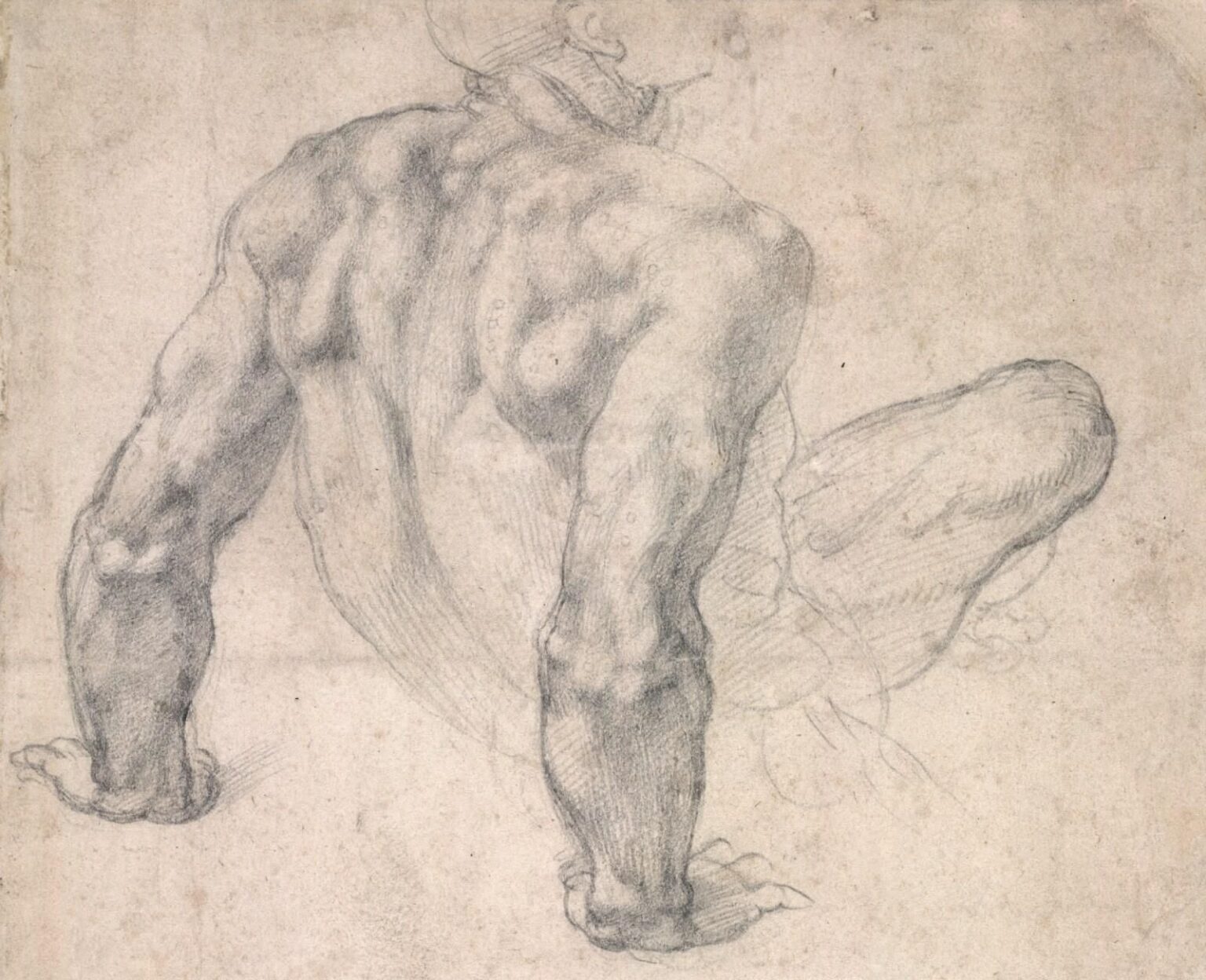
By Staff Middle Land
By Sarah Vowles
In 1534, Michelangelo Buonarroti was 59 years old and already the most celebrated artist in Europe.
He had mastered the fields of sculpture, painting and architecture, and was a gifted amateur poet. Now, as he moved from his native Florence back to Rome – where Pope Clement VII had commissioned him to paint the Last Judgment in the Sistine Chapel – he would have been justified in assuming that he was beginning to wind down his long and varied career. But, as exhibition curator Sarah Vowles explores, it marked an exciting new beginning…
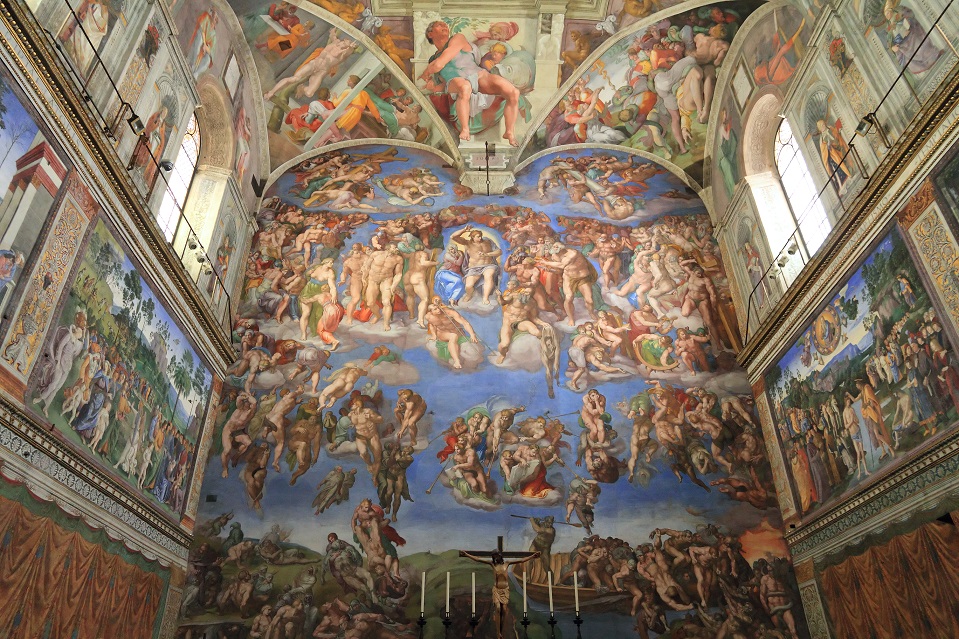
In the 16th century, 60 was a very respectable age to live to – and Michelangelo can hardly have expected to live for a further 30 years after returning to Rome. But in the last three decades of his life, until his death at the age of almost 89, he was busier than he had ever been, as successive popes drew on his expertise and imagination to commission a series of increasingly demanding projects. It is this late and unexpectedly energetic period that forms the focus of our exhibition Michelangelo: the last decades (2 May – 28 July 2024).
The return to Rome
First, there was the Last Judgment, painted on the wall directly beneath the superb Sistine Chapel ceiling that had helped to make Michelangelo’s name in his thirties. As a fresco, this had to be painted onto wet plaster, a careful day-by-day process that required a great deal of advance planning, and which resulted in a series of wonderful preparatory drawings, ranging from dynamic compositional designs from early in the process, to refined final studies of heads and figures.
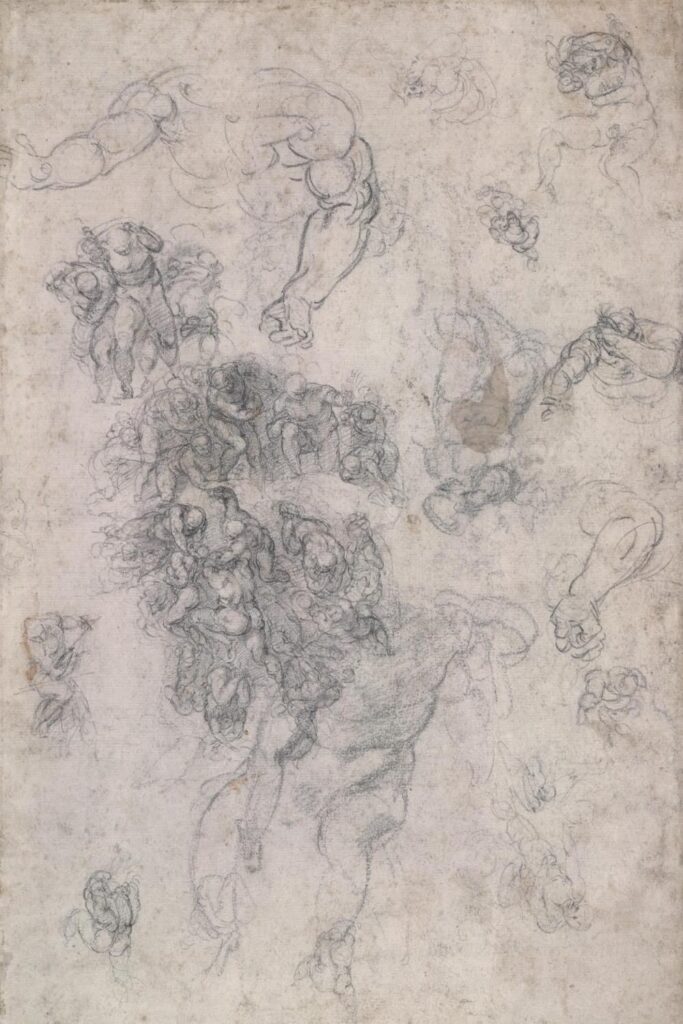
But this wasn’t the end of the pope’s ambitions for Michelangelo. Next, there were two further frescoes in the neighbouring Pauline Chapel, the pope’s private place of prayer. And then there was the greatest and most challenging project of them all: supervision of the building site at St Peter’s, where the church at the very centre of the Catholic world was rising, phoenix-like, from the rubble of the ancient basilica. At one point in the 1540s, venting his frustrations on the back of a study for the Pauline Chapel, Michelangelo had grumbled, ‘I’m not an architect,’ but his patrons weren’t listening: in the final 20 years of his life, he was involved in projects for the Palazzo Farnese, the Porta Pia and the Piazza del Campidoglio, not to mention St Peter’s iconic dome, ultimately stamping his vision upon the very fabric of Renaissance Rome.
Michelangelo had always preferred to work alone but now, as he struggled with ill health and the physical challenges of old age, he had to learn to adapt. He formalised a system which he’d occasionally used in his younger days, working in collaboration with a specialist panel painter in order to satisfy demand from non-papal patrons. Michelangelo would create a composition which the painter – usually Marcello Venusti, his chief collaborator – then translated onto panel, adding a setting and other details from his own imagination. For example, Michelangelo’s designs for The Purification of the Temple, conceiving the figures in the shape of a lunette (a crescent), were adapted by Venusti in an upright painting which placed them among dramatic Solomonic columns (with a twisting shaft), intended to evoke not only the Temple in Jerusalem, but also St Peter’s itself. The collaborative system was immensely successful: it allowed patrons to own a piece of art conceived by the perennially overworked Michelangelo, executed by a colleague with the master’s authority and approval.

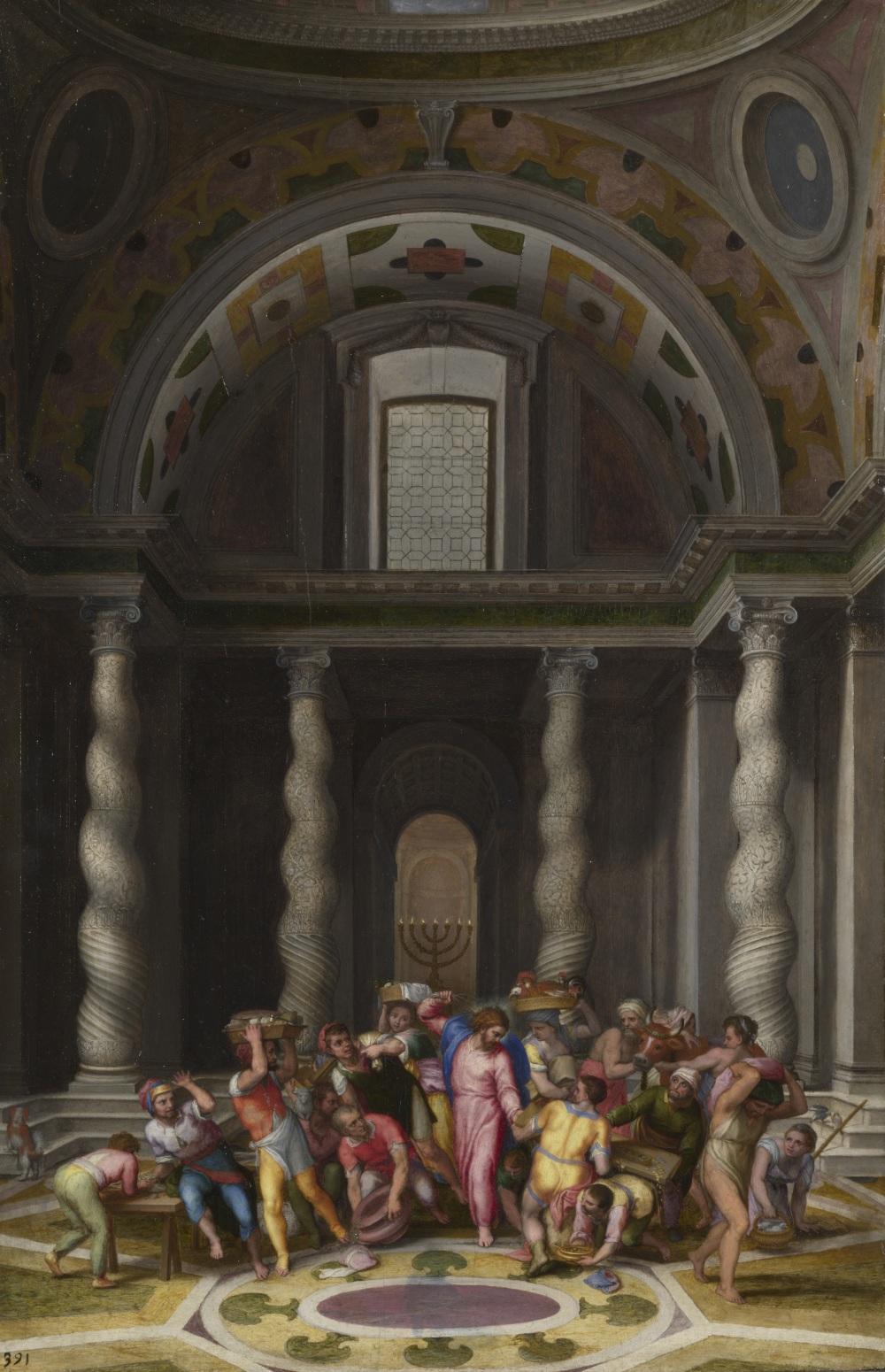
Although Venusti seems to have been Michelangelo’s preferred partner, he did also design or give his compositions to other artists: most notably, the towering cartoon (a full-scale preparatory drawing) of the Epifania, which seems to have been left in Michelangelo’s workshop after the related commission fell through. This huge drawing, over two metres tall and almost two metres wide, was granted to Michelangelo’s associate Ascanio Condivi, probably in thanks for the flattering biography that Condivi wrote of him in 1553. Condivi himself was at the start of his artistic career and needed a big break; to be given a design by Michelangelo was a huge honour.
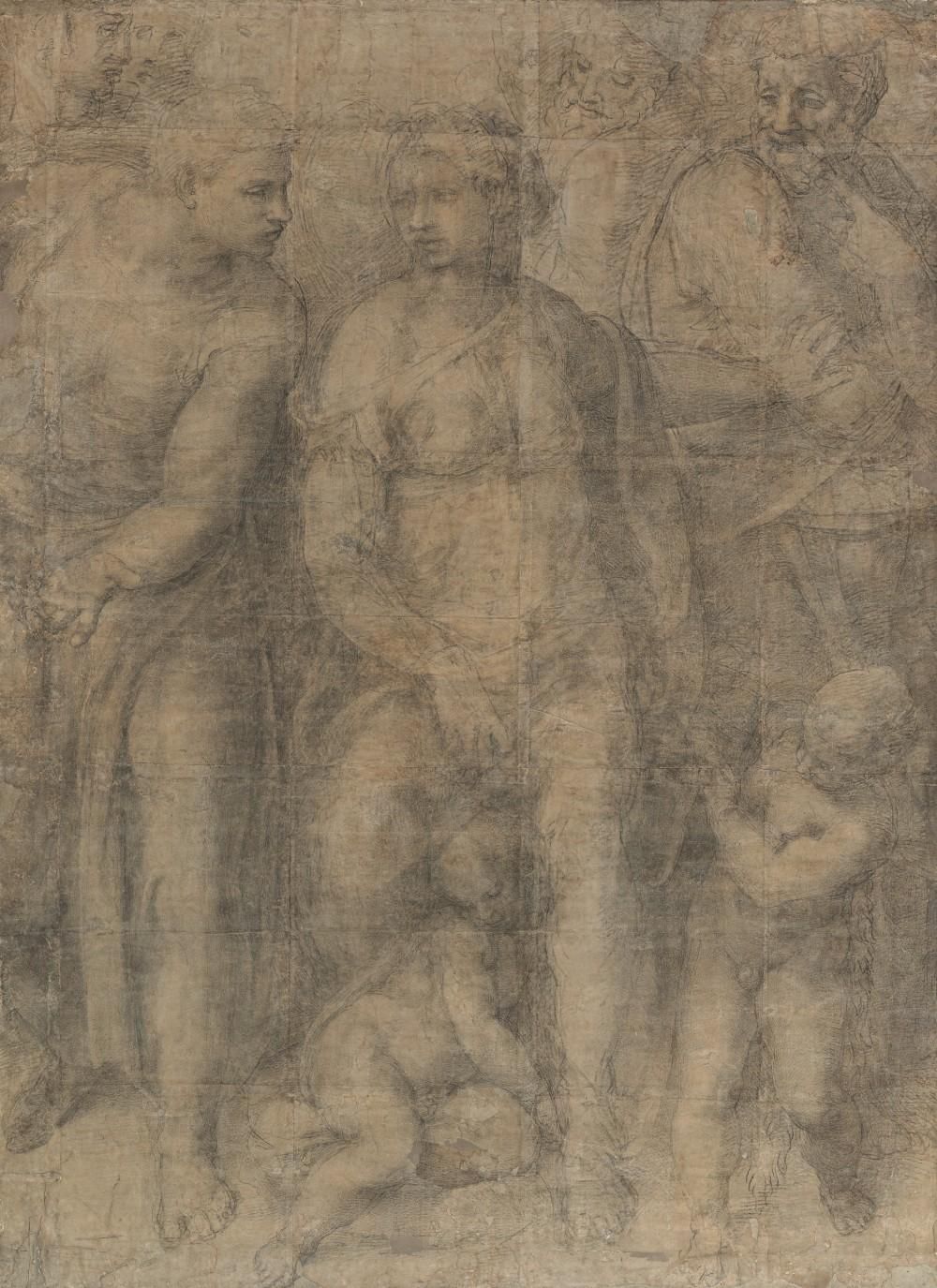
Condivi’s painting of the Epifania is now in the collection of Casa Buonarroti in Florence, the museum set up in Michelangelo’s family home, and has been conserved especially for the exhibition, with support from the British Museum. In the exhibition, it will be reunited with Michelangelo’s drawing of the subject – also newly conserved for the occasion – for the first time since the 16th century.
Private passions
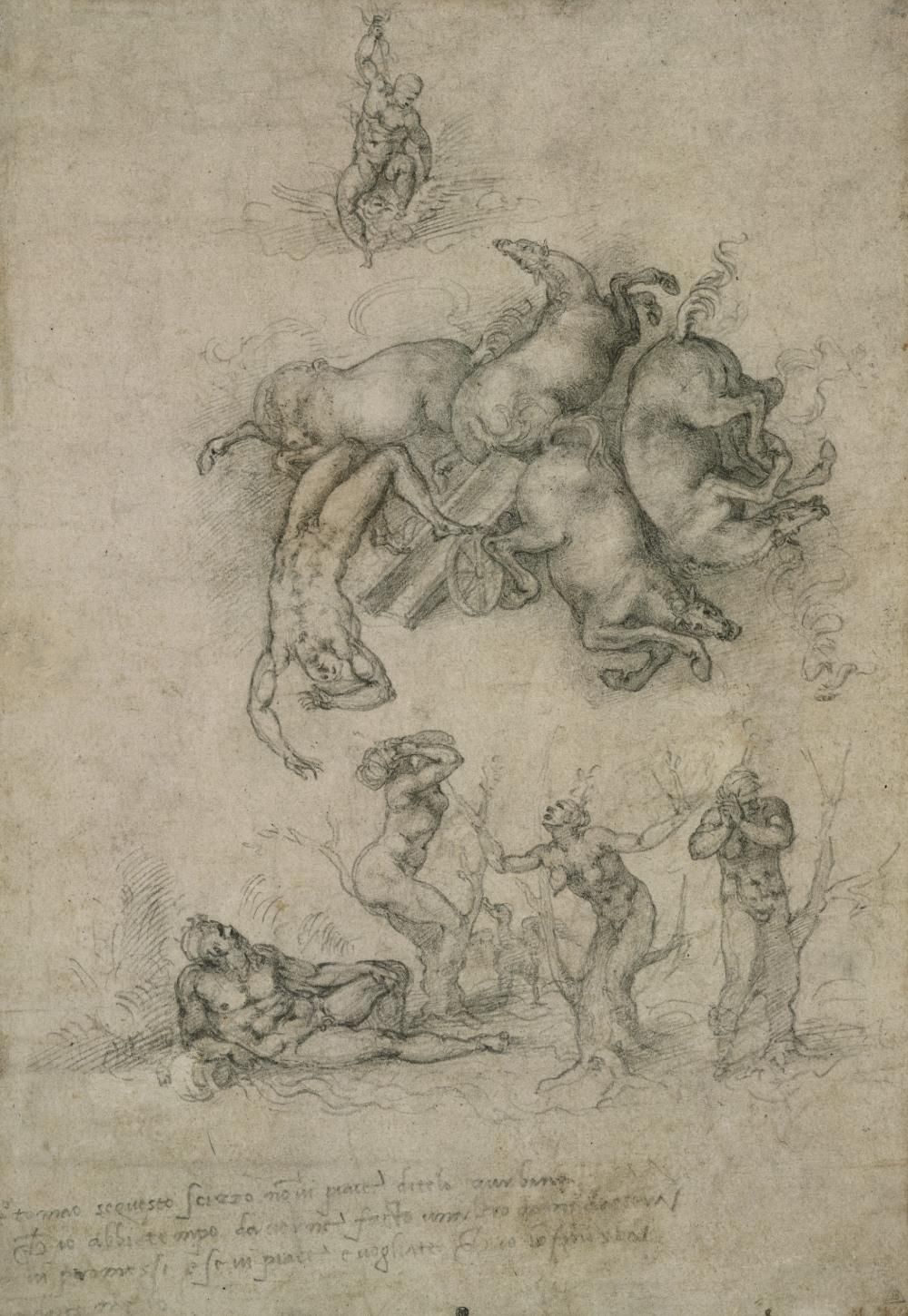
The British Museum exhibition, however, looks beyond Michelangelo the artist and tries to offer visitors a better impression of the man himself. Michelangelo certainly could be gruff and prickly, easily sparked to annoyance, as we see in the lively letters he wrote to his long-suffering nephew Leonardo. But he was also capable of great affection and warmth, and the show considers two of his most significant relationships during this late period, with the young Roman nobleman Tommaso de’ Cavalieri and the aristocratic poet Vittoria Colonna. Both friendships prompted the creation of poems and refined artistic designs which drew on shared interests: for Tommaso, exquisite mythological allegories, such as the Fall of Phaeton, which offered moral guidance to the young man; and, for Vittoria, religious iconography such as Christ on the Cross, which drew on the intensely intimate imagery of reforming movements, evoking the tragedy and triumph of Christ’s death, and his redemption of humankind.

Drawing on faith
Michelangelo was a devout Catholic and, as he grew older, was increasingly worried about the state of his soul. He sent large sums of money to Florence, via his nephew Leonardo, so that it could be used for charitable purposes, and both his art and his poetry show a profound and intimate engagement with questions of salvation. The intensity of his concern becomes even more understandable when we consider the times in which he lived: Rome was still reeling from the impact of the Reformation in Northern Europe (which challenged many aspects of traditional Catholic doctrine) and the Catholic church was trying to define its response. One of the most moving examples of Michelangelo’s personal exploration of faith is a group of drawings of the Crucifixion, probably made over an extended period of time during the last 10 years of his life, which show the elderly artist turning to the act of drawing as a means of spiritual meditation – using variations on a single theme to explore his feelings about mortality, sacrifice, faith and the prospect of redemption.

Original article: British Museum
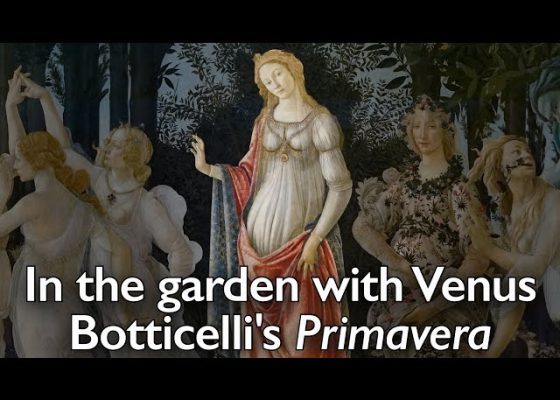



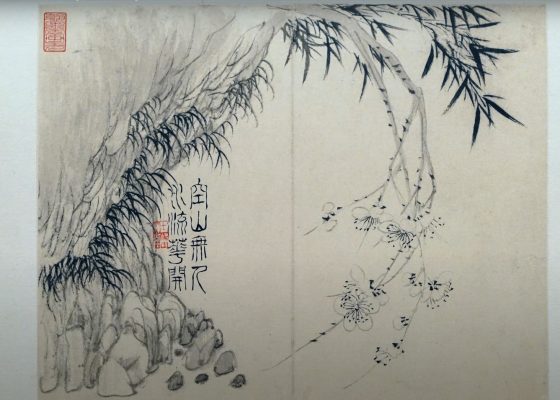




Cancel anytime


Using our website
You may use the The Middle Land website subject to the Terms and Conditions set out on this page. Visit this page regularly to check the latest Terms and Conditions. Access and use of this site constitutes your acceptance of the Terms and Conditions in-force at the time of use.
Intellectual property
Names, images and logos displayed on this site that identify The Middle Land are the intellectual property of New San Cai Inc. Copying any of this material is not permitted without prior written approval from the owner of the relevant intellectual property rights.
Requests for such approval should be directed to the competition committee.
Please provide details of your intended use of the relevant material and include your contact details including name, address, telephone number, fax number and email.
Linking policy
You do not have to ask permission to link directly to pages hosted on this website. However, we do not permit our pages to be loaded directly into frames on your website. Our pages must load into the user’s entire window.
The Middle Land is not responsible for the contents or reliability of any site to which it is hyperlinked and does not necessarily endorse the views expressed within them. Linking to or from this site should not be taken as endorsement of any kind. We cannot guarantee that these links will work all the time and have no control over the availability of the linked pages.
Submissions
All information, data, text, graphics or any other materials whatsoever uploaded or transmitted by you is your sole responsibility. This means that you are entirely responsible for all content you upload, post, email or otherwise transmit to the The Middle Land website.
Virus protection
We make every effort to check and test material at all stages of production. It is always recommended to run an anti-virus program on all material downloaded from the Internet. We cannot accept any responsibility for any loss, disruption or damage to your data or computer system, which may occur while using material derived from this website.
Disclaimer
The website is provided ‘as is’, without any representation or endorsement made, and without warranty of any kind whether express or implied.
Your use of any information or materials on this website is entirely at your own risk, for which we shall not be liable. It is your responsibility to ensure any products, services or information available through this website meet your specific requirements.
We do not warrant the operation of this site will be uninterrupted or error free, that defects will be corrected, or that this site or the server that makes it available are free of viruses or represent the full functionality, accuracy and reliability of the materials. In no event will we be liable for any loss or damage including, without limitation, loss of profits, indirect or consequential loss or damage, or any loss or damages whatsoever arising from the use, or loss of data, arising out of – or in connection with – the use of this website.
Last Updated: September 11, 2024
New San Cai Inc. (hereinafter “The Middle Land,” “we,” “us,” or “our”) owns and operates www.themiddleland.com, its affiliated websites and applications (our “Sites”), and provides related products, services, newsletters, and other offerings (together with the Sites, our “Services”) to art lovers and visitors around the world.
This Privacy Policy (the “Policy”) is intended to provide you with information on how we collect, use, and share your personal data. We process personal data from visitors of our Sites, users of our Services, readers or bloggers (collectively, “you” or “your”). Personal data is any information about you. This Policy also describes your choices regarding use, access, and correction of your personal information.
If after reading this Policy you have additional questions or would like further information, please email at middleland@protonmail.com.
PERSONAL DATA WE COLLECT AND HOW WE USE IT
We collect and process personal data only for lawful reasons, such as our legitimate business interests, your consent, or to fulfill our legal or contractual obligations.
Information You Provide to Us
Most of the information Join Talents collects is provided by you voluntarily while using our Services. We do not request highly sensitive data, such as health or medical information, racial or ethnic origin, political opinions, religious or philosophical beliefs, trade union membership, etc. and we ask that you refrain from sending us any such information.
Here are the types of personal data that you voluntarily provide to us:
As a registered users or customers, you may ask us to review or retrieve emails sent to your business. We will access these emails to provide these services for you.
We use the personal data you provide to us for the following business purposes:
Information Obtained from Third-Party Sources
We collect and publish biographical and other information about users, which we use to promote the articles and our bloggers who use our sites. If you provide personal information about others, or if others give us your information, we will only use that information for the specific reason for which it was provided.
Information We Collect by Automated Means
Log Files
The site uses your IP address to help diagnose server problems, and to administer our website. We use your IP addresses to analyze trends and gather broad demographic information for aggregate use.
Every time you access our Site, some data is temporarily stored and processed in a log file, such as your IP addresses, the browser types, the operating systems, the recalled page, or the date and time of the recall. This data is only evaluated for statistical purposes, such as to help us diagnose problems with our servers, to administer our sites, or to improve our Services.
Do Not Track
Your browser or device may include “Do Not Track” functionality. Our information collection and disclosure practices, and the choices that we provide to customers, will continue to operate as described in this Privacy Policy, whether or not a “Do Not Track” signal is received.
HOW WE SHARE YOUR INFORMATION
We may share your personal data with third parties only in the ways that are described in this Privacy Policy. We do not sell, rent, or lease your personal data to third parties, and We does not transfer your personal data to third parties for their direct marketing purposes.
We may share your personal data with third parties as follows:
There may be other instances where we share your personal data with third parties based on your consent.
HOW WE STORE AND SECURE YOUR INFORMATION
We retain your information for as long as your account is active or as needed to provide you Services. If you wish to cancel your account, please contact us middleland@protonmail.com. We will retain and use your personal data as necessary to comply with legal obligations, resolve disputes, and enforce our agreements.
All you and our data are stored in the server in the United States, we do not sales or transfer your personal data to the third party. All information you provide is stored on a secure server, and we generally accepted industry standards to protect the personal data we process both during transmission and once received.
YOUR RIGHTS/OPT OUT
You may correct, update, amend, delete/remove, or deactivate your account and personal data by making the change on your Blog on www.themiddleland.com or by emailing middleland@protonmail.com. We will respond to your request within a reasonable timeframe.
You may choose to stop receiving Join Talents newsletters or marketing emails at any time by following the unsubscribe instructions included in those communications, or you can email us at middleland@protonmail.com
LINKS TO OTHER WEBSITES
The Middle Land include links to other websites whose privacy practices may differ from that of ours. If you submit personal data to any of those sites, your information is governed by their privacy statements. We encourage you to carefully read the Privacy Policy of any website you visit.
NOTE TO PARENTS OR GUARDIANS
Our Services are not intended for use by children, and we do not knowingly or intentionally solicit data from or market to children under the age of 18. We reserve the right to delete the child’s information and the child’s registration on the Sites.
PRIVACY POLICY CHANGES
We may update this Privacy Policy to reflect changes to our personal data processing practices. If any material changes are made, we will notify you on the Sites prior to the change becoming effective. You are encouraged to periodically review this Policy.
HOW TO CONTACT US
If you have any questions about our Privacy Policy, please email middleland@protonmail.com
The Michelin brothers created the guide, which included information like maps, car mechanics listings, hotels and petrol stations across France to spur demand.
The guide began to award stars to fine dining restaurants in 1926.
At first, they offered just one star, the concept was expanded in 1931 to include one, two and three stars. One star establishments represent a “very good restaurant in its category”. Two honour “excellent cooking, worth a detour” and three reward “exceptional cuisine, worth a
Thank you for your participation,
please Log in or Sign up to Vote

123Sign in to your account